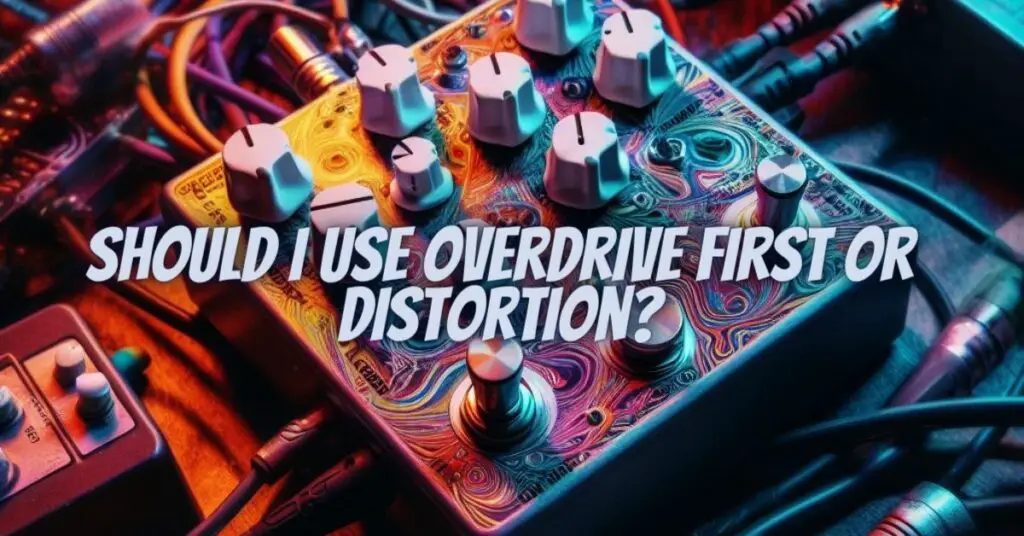One of the most common dilemmas guitarists face when building their pedalboard is deciding whether to place their overdrive pedal before or after their distortion pedal in the signal chain. The order of these two essential effects can significantly impact your guitar tone, so it’s essential to understand the implications of both configurations. In this article, we’ll explore the arguments for using overdrive first and for using distortion first, and we’ll provide insights into how to make the best choice based on your musical style, gear, and tonal objectives.
The Overdrive vs. Distortion Dilemma
Before we delve into the two signal chain options, let’s clarify the primary characteristics of overdrive and distortion:
- Overdrive:
- Overdrive pedals produce a moderate level of gain and add a warm, smooth saturation to your guitar signal. They are known for their touch-sensitive response and the ability to complement the natural overdrive of a tube amplifier.
- Distortion:
- Distortion pedals, on the other hand, provide a higher level of gain and a more aggressive form of clipping. They create a saturated, often compressed, and heavily distorted sound.
Overdrive First: The Pros and Cons
When you place your overdrive pedal before your distortion pedal, you are routing your signal chain in the following manner: Guitar > Overdrive > Distortion > Amplifier. Here are some advantages and considerations for this configuration:
Advantages:
- Tone Shaping: The overdrive pedal can shape your guitar tone before it hits the distortion pedal. This can result in a smoother, more refined distortion, ideal for expressive lead tones.
- Gain Stacking: Placing the overdrive first means you are using it as a gain stage that prepares your signal for the distortion pedal. This often results in a dynamic, harmonically rich, and expressive tone.
- Dynamic Control: This configuration allows for enhanced dynamic control, where you can use your picking technique to vary the level of overdrive. It’s ideal for achieving responsive, expressive tones.
Considerations:
- Less Saturated Distortion: Placing the overdrive first may result in less saturated and intense distortion compared to the opposite configuration. This may not be suitable for genres that demand high-gain tones.
- Harshness: There’s a possibility that combining two gain stages in this manner may lead to a harsh or unpleasant distortion if not well-balanced.
Distortion First: The Pros and Cons
Placing the overdrive pedal after the distortion pedal reverses the signal chain: Guitar > Distortion > Overdrive > Amplifier. Here’s what you need to know about this configuration:
Advantages:
- Volume Boost: The overdrive pedal can provide a clean volume boost when placed after the distortion pedal, allowing you to lift your solos and lead parts above the mix.
- Sustained Lead Tones: This setup enhances the sustain of your lead tones, creating singing, expressive sounds ideal for soloing.
- Lead Tone Shaping: The overdrive pedal’s tone control can refine the harsh high frequencies generated by the distortion, allowing you to achieve a smoother, more controlled lead tone.
Considerations:
- Less Dynamic Control: Placing the overdrive after the distortion may result in less dynamic control and a more saturated overall tone. It may be less ideal for styles that require nuanced picking dynamics.
- Volume Balancing: Balancing the volume levels between the distortion and overdrive pedals can be challenging, as the overdrive may boost the signal significantly.
Making the Right Choice
The decision to place your overdrive pedal before or after your distortion pedal should align with your musical style, gear, and tonal objectives. Here are some factors to consider:
- Musical Style: The style of music you primarily play can guide your choice. If you need a smoother, more expressive lead tone, overdrive-first might be the way to go. For intense, high-gain tones, distortion-first is often preferred.
- Amplifier Characteristics: Consider your amplifier’s natural sound. If your amp already has a heavy, saturated distortion, placing the overdrive first can enhance your soloing capabilities. On the other hand, if your amp has a clean or lightly overdriven tone, placing the distortion first may be more appropriate.
- Gain Level: Think about the level of gain you need. If you’re looking for a smoother, expressive overdrive, overdrive-first might be the right choice. If you need more saturation and lead tone sustain, distortion-first is likely the better option.
- Tonal Preferences: Ultimately, your tonal preferences play a significant role in this decision. Experiment with both configurations to find the sweet spot that complements your playing style and genre.
The choice of whether to place your overdrive pedal before or after your distortion pedal is a matter of personal preference and artistic expression. Both configurations offer distinct tonal characteristics and can significantly impact your overall guitar tone. The key to success lies in selecting the option that best suits your playing style, the style of music you play, your gear setup, and your tonal objectives.
Ultimately, your goal should be to discover the combination that resonates with your unique artistic expression. Experimentation is key to finding the ideal settings and positioning within your signal chain to achieve a sound that captivates and complements your music.

